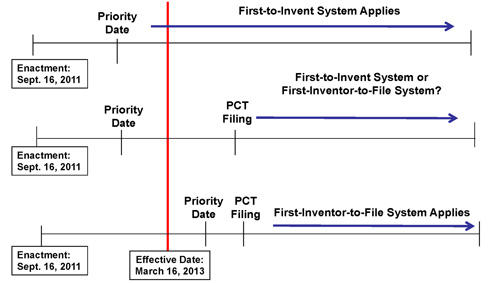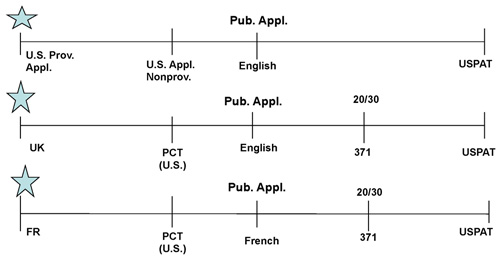
Navigating the New U.S. Patent Filing System
(cont’d)
The First-Inventor-to-File System
The change from a First-to-Invent system to a First-Inventor-to-File system was accomplished by replacing current 35 U.S.C. § 102(a)-(g) with new 35 U.S.C. § 102(a)-(d). Most importantly, new § 102 (1) imposes a near absolute novelty requirement with a limited inventor grace period and (2) redefines the universe of available prior art. As the name of the new system suggests, the basic premise is to award patents to the first filer. In its simplest form, the new system eliminates the possibility of antedating a prior art reference based on earlier invention. For example, the timeline below shows a common scenario that occurs during patent prosecution. Under the old system, if Applicant A’s published application is applied as prior art against Applicant B’s patent application, Applicant B could antedate Applicant A’s filing date by showing earlier inventive activity. Under the new system, however, Applicant B cannot antedate and is precluded from obtaining a patent because he/she was not the first to file.

Straddling the Effective Date of the First-Inventor-to-File System
Because the change to a First-Inventor-to-File system does not apply to applications already pending on the effective date, or to applications only having claims entitled to a priority date earlier than the effective date, it is important to understand how these new changes can impact the prosecution of applications filed after the changes are implemented. The timelines below show three scenarios demonstrating whether the new or old system will govern the prosecution of an application filed after the effective date of the changes. The first timeline shows a clear-cut situation: the First-to-Invent system applies to any application pending before the changes become effective. The third timeline shows a similarly clear case: the First-Inventor-to-File system applies when both the priority date and the application filing date are after the effective date of the changes. The situation is less clear when the priority date and the application filing date straddle the effective date of the new system, as shown in the middle timeline. In this case, if the application included at any time at least one claim not entitled to the earlier priority date, the First-Inventor-to-File system will govern prosecution, even if that claim was cancelled before examination on the merits.

Inventor Grace Period Exception
Despite its name, the new system is not an absolute novelty system because it includes a limited inventor grace period. In particular, the AIA provides a one-year grace period for an inventor’s own work, such as a publication by or obtained from any inventor. For example, if Applicant A publicly discloses first, Applicant A can safely file within one year of that disclosure, even if a third party discloses or files before Applicant A files its patent application. In other words, Applicant A is not precluded from obtaining a patent if a third party files its application between Applicant A’s disclosure and filing dates. Thus, under the new regime, an inventor’s disclosure can act as a placeholder while an inventor prepares its application for filing.
Significant Effective Prior Art Date Changes
The AIA also expands the pool of available prior art. Under the old system, a published U.S. patent application (or a published PCT application that designated the United States and was published in English) qualified as prior art only as of its U.S. (or PCT) filing date, regardless of any foreign priority date. The new regime, however, eliminates all geographical and language distinctions for such applications. Once the changes are implemented, the effective prior art date of such applications will be the earliest filing date to which these applications are entitled to a right of priority, even if the earliest filing date is a foreign priority date. These changes are illustrated in the three timelines that follow this paragraph. As denoted by the star on the first timeline, the published U.S. application qualifies as prior art as of its U.S. provisional filing date under both the new and old regimes. The second and third timelines, however, show how the new regime expands the universe of available prior art. As illustrated in the second timeline, an English international publication of a PCT application designating the United States qualified as prior art under the old system only as of its PCT filing date. Under the new regime, however, that same international publication would qualify as prior art as of the United Kingdom filing date (i.e., the foreign priority date). Similarly, the third timeline shows that, under the new system, the illustrated U.S. patent will qualify as prior art as of the French priority date, regardless of the language of the international publication.

How to Work Within the New System
The AIA’s change from a First-to-Invent system to a First-Inventor-to-File system therefore involves more than simply awarding patents to the first filer. The change not only can result in loss of patent rights, but also can impact the patentability of applications filed after the changes are implemented. Thus, it behooves patent applicants to gain an early understanding of the changes and develop strategies to their benefit. For example, patent applicants should consider filing new nonprovisional applications before the changes become effective, so that these applications will be governed by the First-to-Invent system and avoid the larger pool of prior art. In either system, and most especially in the new system, patent applicants should make every effort to file new applications as soon as possible. If preparing and filing a full nonprovisional application requires significant time, patent applicants should consider filing a provisional application to secure an early priority date. Further, patent applicants should take care when adding claims in applications having priority and filing dates that straddle the effective date of the changes. As explained above, adding to an application a single claim not entitled to a preimplementation priority date, even if that claim is later cancelled, will irreversibly cause the application to proceed under the First-Inventor-to-File regime.